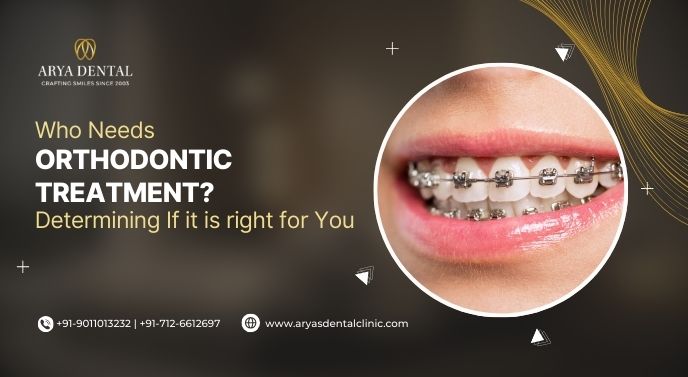
Everyone desires a healthy, beautiful smile, but at times, our teeth may not align as we wish. This is where orthodontic treatment becomes crucial. If you've ever questioned whether you need orthodontic treatment, this blog will provide insights into recognizing common dental issues and determining if it's the right choice for you.
What is Orthodontic Treatment?
Everyone desires a healthy, beautiful smile, but at times, our teeth may not align as we wish. This is where orthodontic treatment becomes crucial. If you've ever questioned whether you need orthodontic treatment, this blog will provide insights into recognizing common dental issues and determining if it's the right choice for you.
What is Orthodontic Treatment?
Orthodontic treatment focuses on correcting the alignment of your teeth and jaws. It involves using devices like braces, clear aligners, or other appliances to gradually move teeth into their proper positions. Orthodontic treatment isn't just about aesthetics—it is crucial in improving oral health, making it easier to clean teeth, and preventing future dental issues. But how do you know if you need orthodontic treatment?
Recognizing Common Dental Problems
Crowded Teeth
Crowding occurs when there isn't enough space in the jaw for teeth to fit properly. As a result, teeth overlap, twist, or get pushed to the front or back of the jaw. This makes it difficult to clean teeth properly, which leads to the risk of cavities and gum disease. Crowding is one of the main reasons people seek orthodontic treatment.
Gaps Between Teeth
Too much space between teeth can affect your bite and cause food to get trapped between teeth, leading to gum problems and decay. Orthodontic treatment can close the gaps and create a more uniform appearance.
Overbite
An overbite happens when the upper teeth overlap the lower teeth more than they should. A slight overlap is normal, but when it's too much, it can wear down your teeth over time and lead to issues like jaw pain or difficulty biting. Severe overbites may require orthodontic treatment to prevent damage to your teeth and improve your bite.
Underbite
An underbite is when the lower teeth sit in front of the upper teeth when you close your mouth. This misalignment can cause chewing difficulties, speech problems, and even facial asymmetry in severe cases. Correcting an underbite with orthodontic treatment can improve both function and appearance.
Crossbite
A crossbite occurs when some of your upper teeth sit inside your lower teeth when you bite down. This can happen with one tooth or several teeth, and it can cause uneven wear on your teeth, gum recession, and even jaw issues. Orthodontic treatment can help reposition your teeth to fix this misalignment.
Open Bite
An open bite means that when you close your mouth, your upper and lower teeth don’t touch in the front, leaving a gap. This makes it hard to bite into food and can lead to speech difficulties. An open bite often requires orthodontic treatment to align the teeth properly.
Jaw Pain or Discomfort
If you experience frequent jaw pain or discomfort, especially when chewing, it could be a sign of a misaligned bite. Jaw issues like temporomandibular joint (TMJ) disorders are often linked to problems with how your teeth fit together. Orthodontic treatment can help alleviate these issues by aligning your teeth and bite.
How to Determine if Orthodontic Treatment is Right for You
Here are a few factors to consider:
Consult with an Orthodontist
The best way to find out if you need orthodontic treatment is to consult a specialist. An orthodontist can examine your teeth, take X-rays, and determine if you have any alignment issues that could benefit from treatment.
Age is Not a Limiting Factor
Orthodontic treatment is not just for kids or teenagers. Many adults can benefit from it as well. In fact, with modern advancements like clear aligners (such as Invisalign), adults now have more discreet options to straighten their teeth.
Aesthetic Concerns
If you’re self-conscious about your smile due to crooked or misaligned teeth, orthodontic treatment can dramatically improve the appearance of your teeth. A confident smile is a powerful asset.
Difficulty Cleaning Teeth
Crowded or overlapping teeth can make it difficult to floss and brush effectively, leading to plaque buildup, cavities, and gum disease. Orthodontic treatment can help you improve oral hygiene by aligning your teeth for easier cleaning.
Bite Problems
If you have difficulty chewing or experience discomfort while eating, you may have a bite problem that requires orthodontic intervention. Correcting bite issues can improve the functionality of your teeth and jaws.
Types of Orthodontic Treatment
Orthodontic treatment depends on your specific dental needs, your orthodontist may recommend one or a combination of the following treatments:
- Braces – Traditional metal braces are very effective for correcting misaligned teeth.
- Clear Aligners – A more discreet option like Invisalign, which uses custom-made trays to shift your teeth into place gradually.
- Retainers – Usually worn after orthodontic treatment to maintain the results and prevent teeth from shifting back.
If you are looking for orthodontic treatment in Nagpur, visit Arya Dental Clinic for a professional evaluation.